Barber J.R. Intermediate Mechanics of Materials
Подождите немного. Документ загружается.


8.2 The circumferential stress 395
sectional cut (e.g. A−A in Figure 8.4) and it corresponds to a line perpendicular to
the axis of symmetry. By contrast, the radius R
2
is perpendicular to the local tangent
to the shell.
A particular case that demonstrates this distinction is the sphere. Everyone would
agree from symmetry that a sphere of radius a has its principal radii equal at all points
— i.e. that R
1
= R
2
= a. However, if we think of the sphere as a special case of an
axisymmetric shell, we would immediately determine R
1
=a, but the radius r would
then vary depending on whether we were looking near the poles or near the equator
[see Figure 8.12 (b)].
shell wall
r
R
2
2
O
O
R
2
= a
r
(a) (b)
Figure 8.12: (a) Distinction between the cross-sectional radius r and the circumfer-
ential radius of curvature of the shell R
2
, (b) Radii r and R
2
for the sphere
By contrast, if we construct the normal to the shell at any point and define R
2
as the distance along the normal to the axis of symmetry, we see that this leads to
the correct conclusion that R
2
= a and that the centres O
1
,O
2
for both radii lie at the
centre of the sphere for all points on the surface.
8.2.2 Sign conventions
The formula
σ
1
R
1
+
σ
2
R
2
=
p
t
(8.2)
was obtained under the assumptions that
σ
1
,
σ
2
are tensile positive and that the cen-
tres O
1
,O
2
corresponding to the radii R
1
,R
2
are both on the same side of the shell as
the pressure p.
Sometimes the two centres are on opposite sides of the shell, in which case the
surface is locally saddle-shaped, as shown in Figure 8.13. Consider, for example
the inside surface of a doughnut. This kind of curvature is sometimes referred to as
anticlastic.

396 8 Membrane Stresses in Axisymmetric Shells
Figure 8.13: Shell element with anticlastic curvature
In addition, the pressure — if there is one – may be on the outside of the shell,
as in the case of the shell of a submarine subjected to water pressure.
By referring to the derivation of equation (8.2), it is easily verified that it applies
to such cases provided we follow the conventions:-
(i) The radius R
2
is always taken to be positive.
(ii) The radius R
1
is taken to be negative if the two centers of curvature O
1
,O
2
are
on the opposite sides of the shell (i.e. if the local region of shell has anticlastic
curvature) and positive if they are on the same side of the shell.
(iii) The pressure p is taken as positive if it acts on the inside surface of the shell
(nearer to the axis) and negative if it acts on the outside surface.
Example 8. 2
Find the circumferential membrane stress
σ
2
for the conical tank of Figure 8.3 as a
function of height z. Find also the maximum shear stress in the tank.
For the conical tank, we have R
1
= ∞, since a side view of the cone exhibits
straight sides. To determine R
2
, we draw a normal to the shell surface at height z as
shown in Figure 8.14, and extend it until it cuts the axis of symmetry.
α
α
shell wall
z
r
R
2
Figure 8.14
From the geometry of this figure, we note that the cross-sectional radius
r = ztan
α

8.2 The circumferential stress 397
and hence
R
2
=
r
cos
α
=
ztan
α
cos
α
.
We also note that the internal pressure at height z is
p =
ρ
g(h −z) .
Using these values in equation (8.2), we have
σ
2
cos
α
ztan
α
+
σ
1
∞
=
ρ
g(h −z)
t
and hence
σ
2
=
ρ
g(h −z)ztan
α
t cos
α
.
It follows that the maximum value of
σ
2
occurs at z=h/2 and is
σ
max
2
=
ρ
gh
2
tan
α
4t cos
α
,
which is greater than the maximum meridional stress
σ
max
1
=
3
ρ
gh
2
tan
α
16t cos
α
found in §8.1 above.
In this example, R
1
=∞ and hence
σ
1
does not enter into the equation. However,
in general, we have to find
σ
1
first by the method of §8.1, so that it can be eliminated
in equation (8.2) to determine
σ
2
.
The maximum shear stress at any given point in the shell is the largest of
σ
1
−
σ
2
2
,
σ
2
−
σ
3
2
,
σ
3
−
σ
1
2
,
where
σ
1
,
σ
2
,
σ
3
are the three principal stresses (see §2.1.2). In membrane stress
problems,
σ
1
,
σ
2
are the two membrane stresses and
σ
3
is the stress on the local
tangent plane to the shell. This generally varies through the shell thickness, since
one side is loaded by fluid pressure, whilst the other is traction-free. However, the
fact that the shell is thin-walled guarantees that |
σ
3
|≪|
σ
1
|,|
σ
2
|. For example, in
computing
σ
1
, the pressure force acting over the area
π
r
2
is resisted by the force
due to
σ
1
acting over the area 2
π
rt, showing that
σ
1
is greater than p in the ratio of
at least r/2t. We can therefore approximate
σ
3
as zero in computing the maximum
shear stress.
In the present example, both membrane stresses are everywhere tensile, so the
maximum shear stress is
τ
max
=
max(
σ
1
,
σ
2
) −0
2
.
The maximum membrane stress is
σ
max
2
(see above) and hence
τ
max
=
ρ
gh
2
tan
α
8t cos
α
.
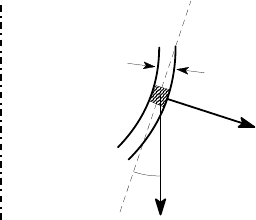
398 8 Membrane Stresses in Axisymmetric Shells
8.3 Self-weight
So far, we have neglected the weight of the shell itself, which is usually a reasonable
approximation for thin-walled shells subjected to pressure loading. However, there
are cases (notably in civil engineering applications) where a significant part of the
loading is associated with the self-weight of the structure.
The meridional stress
σ
1
is determined exactly as in §8.1, except that the weight
of the shell is included as an additional term in the equilibrium equation. In this
calculation, it is sometimes useful to note that the volume of material in a shell of
uniform thickness is approximately equal to the product of the mean surface area of
the shell and the thickness.
n
t
ρgt per unit area
α
Figure 8.15: Self-weight of the shell has a component equivalent to an additional
pressure
The self-weight of the shell also plays a rˆole in the determination of the circum-
ferential stress
σ
2
, since, in general, it has a component in the direction normal to
the shell and hence modifies equation (8.2). For example, the small element of shell
shown in Figure 8.15 is subject to a gravitational force of
ρ
gt per unit area, where
t is the local thickness. This force has a component
ρ
gt sin
α
in the direction of the
outward normal n, and hence has the same effect as an additional internal pressure
of magnitude
ρ
gt sin
α
, where
α
is the angle between the local tangent to the shell
and the vertical, as shown in Figure 8.15. It is important to check the direction of this
component to make sure whether the resolved component is in the direction of the
outward or the inward normal to the shell, since this will determine the sign of the
additional term in equation (8.2).
Example 8. 3
Figure 8.16 shows a spherical roof shell of mean radius a and uniform thickness t,
loaded only by its own weight. Find the membrane stresses as functions of the polar
angle
φ
if the material has density
ρ
s
.
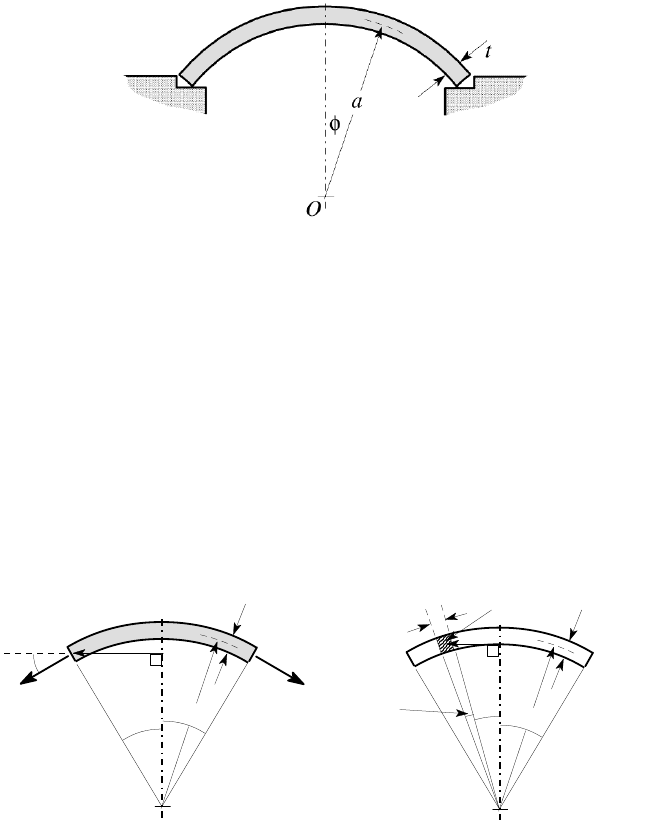
8.3 Self-weight 399
Figure 8.16: Spherical roof shell
To determine
σ
1
, we cut out the section of shell above the polar angle
φ
, illus-
trated in Figure 8.17 (a). The cross-sectional radius r is then
r = asin
φ
and the meridional stress acts on the area of the cut through the shell thickness, which
is 2
π
rt (the product of circumference and thickness). Axial equilibrium therefore
requires that
σ
1
(2
π
rt)sin
φ
+W = 2
πσ
1
at sin
2
φ
+W = 0 ,
where W is the weight of the shell segment and the factor sin
φ
in the first term is
required to resolve the force due to
σ
1
into the vertical direction.
a
φ
O
φ
φ
t
r
σ
1
σ
1
a
φ
O
t
r
θ
dθ
a dθ
at dθ
(a) (b)
Figure 8.17
To find the weight W we need to perform an integration. We first note that a
small angle d
θ
at the centre of the sphere corresponds to a segment of shell of length
ad
θ
, as shown in Figure 8.17 (b). This in turn defines an annular ring of material of
radius r=a sin
θ
and cross-sectional area atd
θ
, shown shaded in Figure 8.17 (b). The
weight of this ring is
dW = 2
π
ratd
θρ
s
g = 2
πρ
s
ga
2
t sin
θ
d
θ
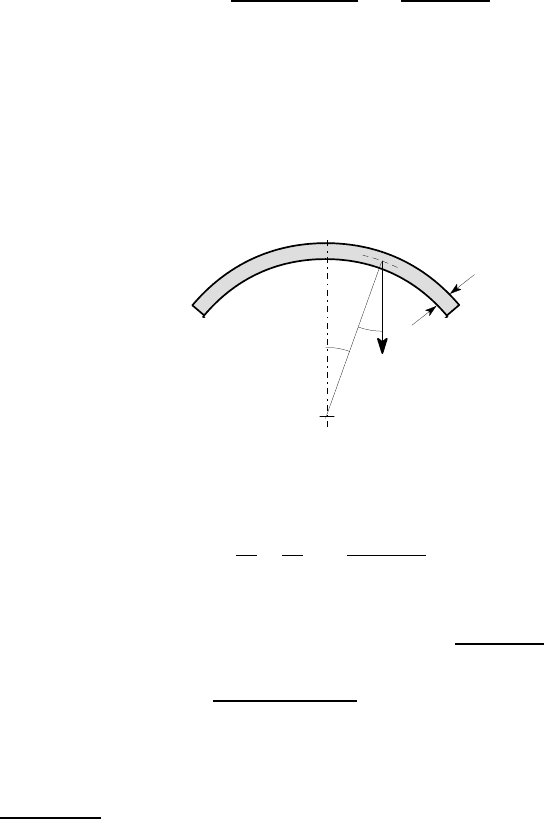
400 8 Membrane Stresses in Axisymmetric Shells
and the total weight W is obtained by summing such rings by integration, with the
result
W =
Z
φ
0
dW = 2
ρ
s
g
π
a
2
t
Z
φ
0
sin
θ
d
θ
= 2
ρ
s
g
π
a
2
t(1 −cos
φ
) .
Substituting this result into the equilibrium equation, we then have
2
πσ
1
at sin
2
φ
+ 2
ρ
s
g
π
a
2
t(1 −cos
φ
) = 0
and hence
σ
1
= −
ρ
s
ga(1 −cos
φ
)
sin
2
φ
= −
ρ
s
ga
(1 + cos
φ
)
,
since sin
2
φ
=1−cos
2
φ
. Notice that
σ
1
is compressive, as we should expect, and that
it is bounded at the top,
φ
= 0, where
σ
1
=−
ρ
s
ga/2.
The circumferential stress
σ
2
can be determined from equation (8.2). In the
present case there is no internal pressure p, but as in Figure 8.15, the self-weight,
ρ
s
gt per unit area has a component along the local normal to the shell. The direction
of this force is shown in Figure 8.18 and it has a component along the inward nor-
mal of
ρ
s
gt cos
φ
. This simulates an external pressure, which is treated as negative,
following the conventions of §8.2.2.
φ
t
φ
ρgt per unit area
O
Figure 8.18
For the sphere, the two radii are R
1
=R
2
=a, so equation (8.2) takes the form
σ
1
a
+
σ
2
a
= −
ρ
s
gt cos
φ
t
,
from which
σ
2
= −
ρ
s
ga cos
φ
−
σ
1
=
ρ
s
ga
−cos
φ
+
1
(1 + cos
φ
)
=
ρ
s
ga
1 −cos
φ
−cos
2
φ
1 + cos
φ
.
It follows that
σ
2
also tends to −
ρ
s
ga/2 as
φ
→0. In fact, we shall always find
that
σ
1
=
σ
2
at any point where a shell crosses the axis of symmetry without a dis-
continuity in slope
5
or a concentrated force.
5
An axisymmetric shell with slope continuity must be locally spherical at a point where it
crosses the axis, since all diameters at this point are equivalent.

8.4 Relative magnitudes of different loads 401
The circumferential stress
σ
2
is compressive near
φ
= 0, but becomes tensile if
cos
φ
+ cos
2
φ
< 1, which corresponds to the range
φ
> 51.8
o
. This is a factor of
importance if the shell is to be constructed from a material like concrete, which has
a higher strength in compression than in tension.
8.4 Relative magnitudes of different loads
In the preceding sections, we have considered examples of shells loaded by internal
pressure, the weight of the contents and the self-weight of the shell. In many practi-
cal applications, all these forms of loading will be present, but usually the membrane
stresses will be dominated by one of them and the others can conveniently be ne-
glected, as discussed in §1.3.
The weight of a contained fluid causes the pressure to increase with depth, so that
at depth h, p =
ρ
gh. If the surface of the fluid is exposed to atmospheric pressure,
the weight of the contents are therefore responsible for the principal pressure load-
ing of the structure and must be included in the analysis. However, in some cases a
vessel may contain a liquid above which there is a gas (usually vapour) at above at-
mospheric pressure. A typical example is a boiler delivering pressurized steam. The
loading from the gas pressure will usually be significantly larger than that from the
weight of the fluid, which can therefore be neglected. To test whether this approxi-
mation is legitimate, calculate the maximum pressure change
ρ
gh, between the top
and bottom of the contained fluid and compare it with the gas pressure.
Example 8. 4
A spherical boiler of diameter 6 ft is full to the 4 ft mark with water and delivers
steam at a pressure of 200 psi. Is it necessary to include the weight of the water in a
membrane stress calculation? The density of water is 60 lb/ft
3
.
The head of water between the bottom of the boiler and the water surface is
ρ
gh =
60 ×4 ×12
12
3
= 1.67 psi .
This is less than 1% of the steam pressure (200 psi), so the weight of the water can
reasonably be neglected.
A shell is by definition thin and hence the volume of shell material is orders
of magnitude smaller than that of the contained volume. It follows that the self-
weight of the shell will be significantly smaller than that of any liquid contents,
even allowing for the fact that the shell material will typically have a density several
times larger than that of the contents. After all, a full saucepan or water bottle is
considerably heavier than an empty one. We have seen that the pressure due to fluid
weight is
ρ
gh. In view of equation (8.2), this leads to membrane stresses of the order
ρ
gha/t, where a is a representative shell radius.
By contrast, the self-weight of the shell will typically yield stresses of the order
ρ
s
gl, where
ρ
s
is the density of the shell material and l is a representative shell

402 8 Membrane Stresses in Axisymmetric Shells
dimension. The results of the preceding examples confirm this general behaviour.
For the conical shell with a contained fluid, we obtained
σ
max
1
=
3
ρ
gh
2
tan
α
16t cos
α
;
σ
max
2
=
ρ
gh
2
tan
α
4t cos
α
,
both of which contain the factor
ρ
gh
2
/t (since for the cone, radius a is proportional
to height h). The spherical roof shell of Example 8.3 yields the membrane stresses
σ
1
= −
ρ
s
ga
(1 + cos
φ
)
;
σ
2
=
ρ
s
ga
1 −cos
φ
−cos
2
φ
1 + cos
φ
,
both of which contain the factor
ρ
s
ga, where a is the radius of the sphere.
In view of these considerations, shell self-weight can almost always be neglected
when there is a contained liquid, but this hypothesis can always be tested in particular
cases by comparing representative estimates of
ρ
s
gl and
ρ
gha/t. A similar compar-
ison can be made when a heavy shell is subjected to pressure loading p, using pa/t
as a representative membrane stress.
Example 8. 5
A concrete chimney of height 20 m, mean radius 0.8 m and wall thickness 100 mm is
subject to a maximum pressure difference between inside and outside of 0.05 atm (5
KPa). The density of concrete is 2300 kg/m
3
. Can either of the two forms of loading
be neglected in a membrane stress calculation?
We compute
pa
t
=
5 ×10
3
×0.8
0.1
= 40 ×10
3
Pa
ρ
s
gh = 2300 ×9.81 ×20 = 450 ×10
3
Pa
and conclude that in this case the loading from self-weight is dominant, at least near
the base of the chimney, so the pressure loading can reasonably be neglected, as long
as a 10% error is acceptable.
8.5 Strains and Displacements
Once the stresses are known, the strains and hence the deformation of the shell can
be calculated. However, the predicted displacements may be constrained either by
a support or by a point of connection between two segments of shell with different
radii. In such cases, the shell experiences local bending.
Since the shell is axisymmetric, only radial and axial displacements are possible.
Axial displacements u
z
are seldom of importance unless the change in contained
volume in the shell due to internal pressure is required or the shell is prevented by
the support system from axial expansion or contraction. The existence of a radial
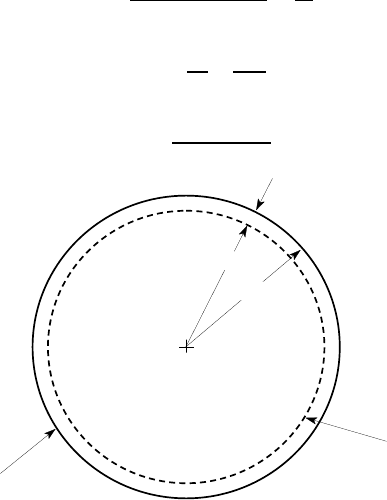
8.5 Strains and Displacements 403
displacement u
r
implies that the local diameter and hence the local circumference
of the shell has increased, as shown in Figure 8.19. It follows that there must be a
circumferential (hoop) strain e
θθ
or e
2
. In the undeformed view, the radius in the
cross section is r. After deformation, it is r+u
r
, since all points move a distance u
r
outwards. Hence, the new circumference is 2
π
(u
r
+r) and the circumferential strain
is
e
2
=
2
π
(u
r
+ r) −2
π
r
2
π
r
=
u
r
r
. (8.3)
But, by Hooke’s law,
e
2
=
σ
2
E
−
νσ
1
E
(8.4)
and hence
u
r
=
(
σ
2
−
νσ
1
)r
E
. (8.5)
r
u
before deformation
after deformation
r
u
r +
r
Figure 8.19: Circumferential strain due to radial displacement u
r
Example 8. 6
A spherical tank has mean radius 1 m, wall thickness 5 mm, and is made of steel for
which E = 210 GPa,
ν
= 0.3. It is completely full of water at atmospheric pressure.
An additional 0.01 m
3
of water is then forced into the tank under pressure. Find
the resulting internal pressure if the water can be treated as incompressible and the
weight of the water and the tank can be neglected.
Suppose the final internal pressure in the tank is p. Cutting the tank on a diameter,
keeping half the water in each half, we can write the equilibrium equation
2
π
×1 ×0.005 ×
σ
1
−
π
×1
2
× p = 0
and hence
σ
1
= 100p .
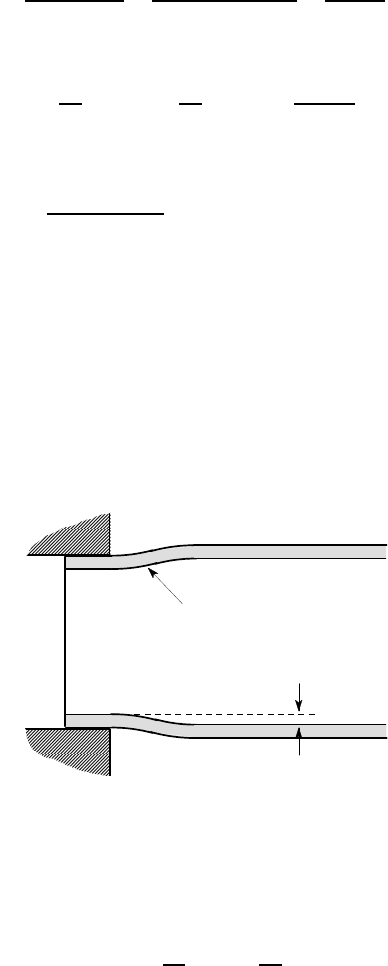
404 8 Membrane Stresses in Axisymmetric Shells
In view of the symmetry of the sphere, we also have
σ
2
=100p.
The radial displacement at all points is therefore
u
r
=
(
σ
2
−
νσ
1
)r
E
=
100p(1 −0.3) ×1
210 ×10
9
=
p
3 ×10
9
m ,
where p is in Pa. The increase in volume of the tank due to this displacement is
∆
V =
4
π
3
(1 + u
r
)
3
−
4
π
3
≈ 4
π
u
r
=
4
π
p
3 ×10
9
m
3
,
but we require
∆
V =0.01 m
3
, so the final pressure must be
p =
3 ×10
9
×0.01
4
π
= 2.4 ×10
6
Pa (2.4 MPa).
8.5.1 Discontinuities
Radial displacements are mainly of concern at the ends of a shell or at points of
discontinuity. For example, suppose a cylindrical shell is built-in to a rigid wall and
subjected to an internal pressure p. Clearly we get a non-zero value for u
r
, since the
stresses are non-zero, but at the end u
r
is constrained to be zero. In practice, the shell
will deform as shown in Figure 8.20 and bending stresses will be developed at the
end. We shall show how to determine the transitional shape and the bending stresses
in Chapter 9.
Figure 8.20: Cylindrical pressure vessel built-in to a rigid wall at one end
A less obvious example concerns the cylinder with hemispherical ends and inter-
nal pressure p, shown in Figure 8.21.
In the cylindrical section, the methods of §§8.1, 8.2 give
σ
1
=
pa
2t
;
σ
2
=
pa
t
internal pressure p
region of
shell bending
r
u
